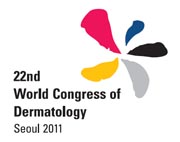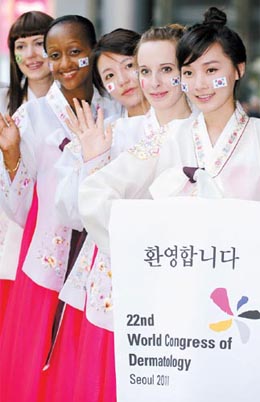Nobel laureate: Cancer vaccine too expensive

According to the latest data from Statistics Korea, cancer claims more lives than any other chronic disease in Korea.
And because there are more than 200 types of cancer caused by any combination of factors and carcinogens, people often think of cancer as a looming danger for which not much can be done to prevent it, aside from quitting smoking and picking up good living habits.
But what if there is a vaccine against cancer? Cervical cancer, which plagued nearly 18,000 patients out of roughly 320,800 Korean female cancer patients in 2009, according to the National Health Insurance Corp., is one of the few cancers known to be caused mostly by a viral infection, one that can be vaccinated against.

Dr. Harald zur Hausen By Jeon Min-gyu
Visiting Korea for the 22nd World Congress of Dermatology, taking place this week in COEX Convention Center in Samseong-dong, southern Seoul, zur Hausen underscored the importance of continuous research into infections linked to the occurrence of cancer during an interview yesterday.
“Currently, 21 percent of all cancers have now been linked with infectious causes,” said zur Hausen said. “But we estimate that number could get up to one-third of all cancers as research progresses,” he added.
Viral infections are a hefty part of the many and varied causes of cancer, which can range from carcinogens or cancer-causing substances such as tobacco smoke and genetic makeup to the state of the immune system.
A major part of zur Hausen’s body of work was done around 1977, when he became the chair of the Institute of Virology at Freiburg, Germany, and led to the isolation of HPV 16 and HPV 18, together responsible for about 70 percent of cervical cancer cases.

Receptionists welcome participants of the 22nd World Congress of Dermatology yesterday at COEX in southern Seoul. [NEWSIS]
Although zur Hausen saw the necessity of a vaccine against these viruses early on, his initial attempts to approach pharmaceutical companies to devise a vaccine in 1984 were shot down due to questions of profitability.
The current vaccines on the market, Gardasil from Merck and Cervarix from GlaxoSmithKline, were only approved for use by the U.S. FDA in 2006 and 2009, respectively.
“My view is that the cost of the vaccines is much too high. They need to be reduced,” said zur Hausen. “But both are very effective vaccines and impossible to compare as each firm’s testing methods are very dissimilar.”
These vaccines, formerly believed to be only effective in females from 9 to 26 years old, are now known to be possibly effective with middle-aged women less than 45 years old. Early inoculation is necessary as the vaccine’s effects take five years on average to appear, according to the Korean Society of Obstetrics and Gynecology.
According to zur Hausen, the world can be a step closer to the complete eradication of cervical cancer - but the high cost of the vaccines is one of the hindrances.
“I understand that we are still far from global dissemination of the vaccines. It’s possible to eradicate cervical cancer to some extent but presently it’s not possible, because the vaccine prices are too expensive,” zur Hausen said.
“It needs some consideration, some policy changes. And it would be good if every girl between the ages of 9 and 15 was to be vaccinated but I believe it could be more effective to vaccinate every boy because they are more sexually active.”
By Lee Jung-yoon [joyce@joongang.co.kr]
한글 관련 기사 [중앙일보]
“예방주사 맞으면 여성 암 발병 15%는 줄어들 것”
서울 온 노벨 생리·의학상 수상자 독일 하랄드 하우젠 박사
“백신 주사를 맞아 독감을 예방하듯이 암도 백신으로 예방할 수 있습니다.”
2008년 노벨 생리·의학상 수상자인 독일의 하랄드 추어 하우젠(75·사진)박사는 “암 백신을 맞으면 여성들이 걸리는 전체 암의 15%는 줄어들 수 있다”고 말했다.
그는 24일부터 서울 삼성동 코엑스에서 열리는 세계피부과학술대회에 특별 강연을 하러 방한했다.
하우젠 박사는 양성 혹의 일종인 사마귀를 생기게 하는 바이러스(HPV·인유두종바이러스)가 여성의 자궁 경부암을 일으킨다는 사실을 밝혀내 노벨상을 받았다. 그의 연구 결과는 자궁 경부암을 예방하는 다양한 예방 백신(가다실, 서바릭스 등)의 개발로 이어졌다.
하우젠 박사는 “B형 간염 백신을 맞은 사람이 간암을 예방할 수 있는 것처럼 HPV 백신을 맞은 여성의 80%가 자궁암 예방효과를 얻을 것으로 추정된다”고 말했다.
그는 이어 “여성의 자궁 경부암을 일으키는 바이러스가 남성의 성기에 생기는 암도 일으킨다”며 “여성용 예방 백신이 남성의 성기에 생기는 암을 예방하는 데 유익할 것”이라고 말했다. 실제로 간암, 위암, 자궁 경부암 등 암환자 5명 중 한 명이 감염성 병을 일으키는 병원체를 통해 암에 걸리고 있다는 것.
하우젠 박사는 여성들을 위해 일상생활 속에서 자궁 경부암을 예방할 수 있는 간단한 실천 방법도 소개했다.
“일본인들이 샤브샤브를 먹는 것을 봤다. 살짝 익혀 바로 꺼내 먹더라. 이 정도 온도에선 바이러스(HPV)가 파괴되지 않는다. 바이러스를 없애려면 82도 이상의 온도에서 충분히 익혀 먹어야 한다.”
그렇다면 한국인들에게 가장 흔한 위암의 발생 원인으로 지목 받고 있는 헬리코박터균의 예방은 어떻게 해야 할까.
하우젠 박사는 “헬리코박터균은 항생제를 사용해 죽이더라도 재감염이 잘 된다는 점에서 위암에 대한 예방효과는 별로 높지 않다”고 말했다.
한편 국내 최대 규모의 국제 학술대회인 이번 학회 발표에서 태양의 자외선뿐 아니라 적외선도 피부 손상과 피부 노화를 유발한다는 국내외 연구 결과가 발표돼 주목을 받았다.










with the Korea JoongAng Daily
To write comments, please log in to one of the accounts.
Standards Board Policy (0/250자)